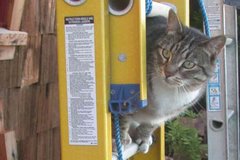Core splitting and core CAS16-03PC preliminary expose
The official CASEIS Cruise Blog is located here: http://www.ipgp.fr/caseis This official blog is written by my shift-mate Lola Johannes.
Core splitting and core CAS16-03PC!
- After labeling and cutting three cores, our shift finally got the opportunity to split some cores. The Oregon State University Marine Geologic Repository and Coring Facility has two similar core splitting devices as this one. Here Dr. Gueorgui Ratzov helps us split our first core. First we place the core section on the track.
- Then we orient the core so that each section is split in the same direction. One half becomes the work half and the other half is the archive half. The work half is the half that is described for litho- and biostratigraphy. Also, we collect U-Channel samples from the work half for paleomagnetic and other analyses to be conducted by Dr. St-Onge and his students in Quebec at the Institut des sciences de la mer de Rimouski. The archive half is used for real color imaging (RGB), photospectrometry, point magnetic susceptibility, and possibly X-Ray Fluorescence.
- Here Gaele is operating the core splitter. She is smiling, so it appears that marine paleoseismology can be fun even on a ship wearing safety glasses, hearing protection, and gloves while operating an instrument that makes a sound like ten thousand pieces of chalk scratching on a chalkboard.
- Here is the result.
- Then Dr. Beck cuts the end caps with a saw. He is careful to cut a straight line and to avoid cutting himself.
- Here Dr. Gueorgui Ratzov shows us the technique to separate the two halves of the sediment using a monofilament (fishing line) wrapped around two pieces of wood as handles.
- Here the seismologist Dr. Frédérique Leclerc, a postdoctoral fellow at the Earth Observatory at Singapore, is getting a narrative about what we are finding in the sediment cores. Dr. Leclerc is working on the ship by processing the CHIRP seismic data so that we can see the subsurface stratigraphy. This helps us select good coring sites.
- Here is our next long core. We brought this on deck at the end of our shift, so the next shift got a chance to label and cut it up. We did get to measure it at 19.35 m, the longest core from this cruise so far. Dr. Beck chats with the engineers who are concerned that we save energy by closing the doors to keep the air conditioner operational. We are grateful for everything that the engineers do to ensure a safe, successful, and comfortable research cruise. We could not do this research without them. We also enjoy chatting and joking with them.

- OK, now for some exciting science (not that everything else is not exciting). This is core CAS16-03PC, the 9.44 m core. The uppermost section is on the left and the top of each core is on the far side of the table (so, sections I to VI from left to right and section VII on the far right, mostly out of view). Drs. Feuillet, St-Onge, and Beck are standing from left to right. Dr. Beck is describing his interpretation of some of the units. There is a very thick deposit (~4.5 m) deposit that spans sections IV through I. The base of this deposit is at about halfway down section IV and the top is about mid-core in section I. The part in section IV and the lowermost part of section III appears to have several sub-units with sedimentary structures showing the direction of deposition switching from left to right. The rest of the overlying part of the deposit appears purely homogeneous mud. Dr. Beck interprets this to be a homogenite. He has published papers about a homogenite in the Sea of Maramara that is related to an earthquake and possibly due to a seiche that formed when an internal wave formed between sediment rich water and overlying water when the motion from a Seismogenic turbidite(s?) resonated with the basin geometry. While I was napping after my shift, the next shift split open core CAS16-04PC to find a similar deposit. We also see this deposit imaged in the CHIRP data.












No comments:
Post a Comment